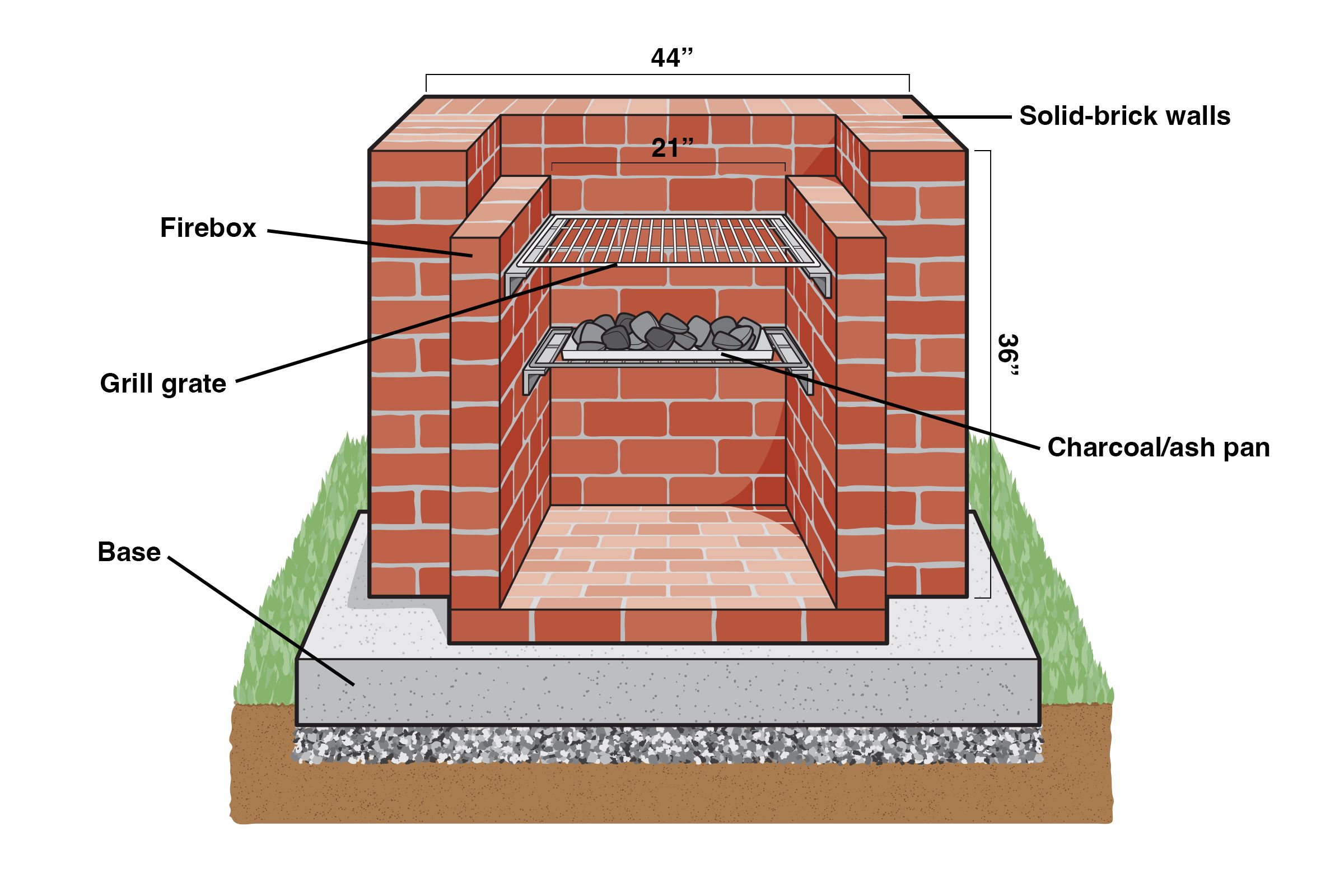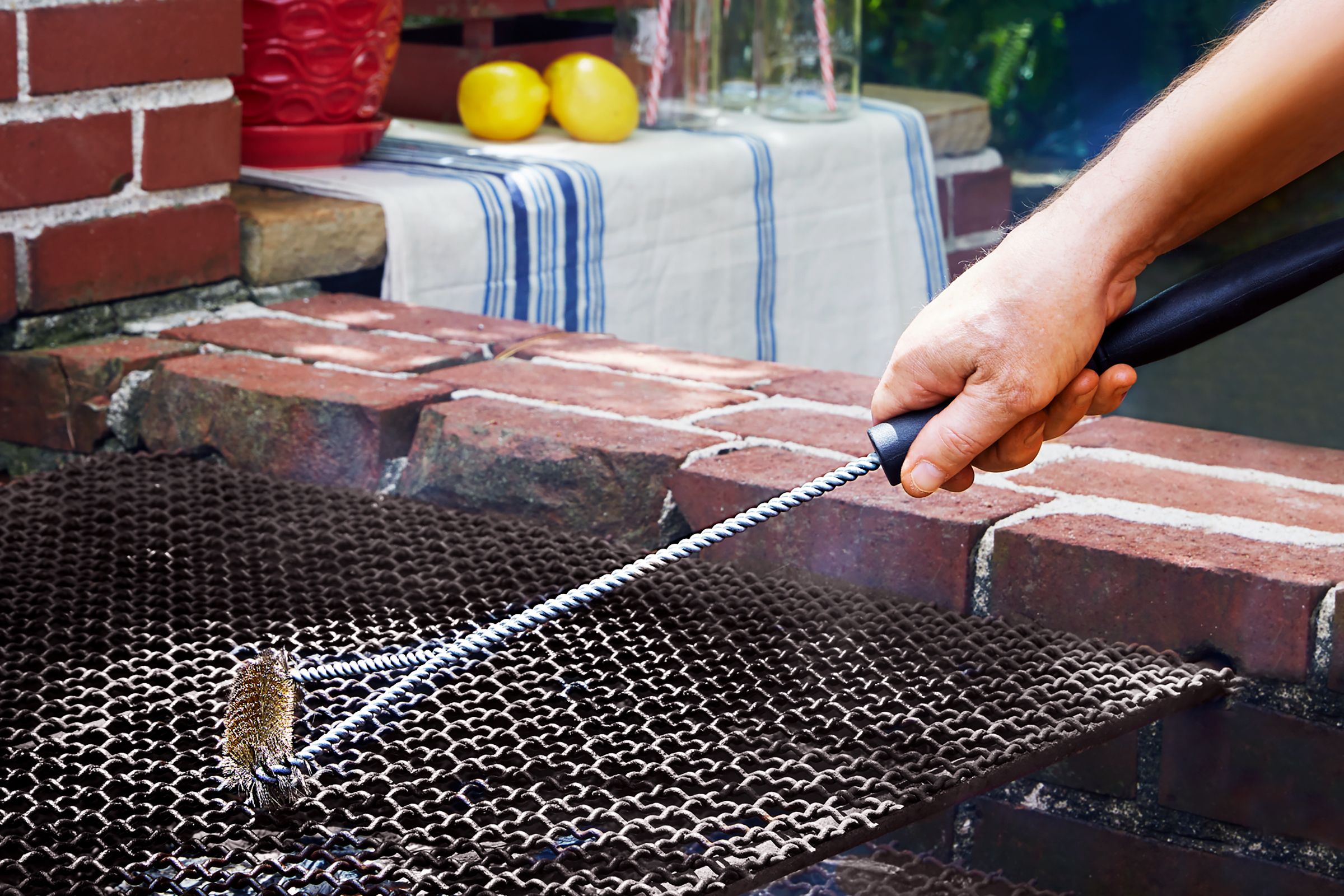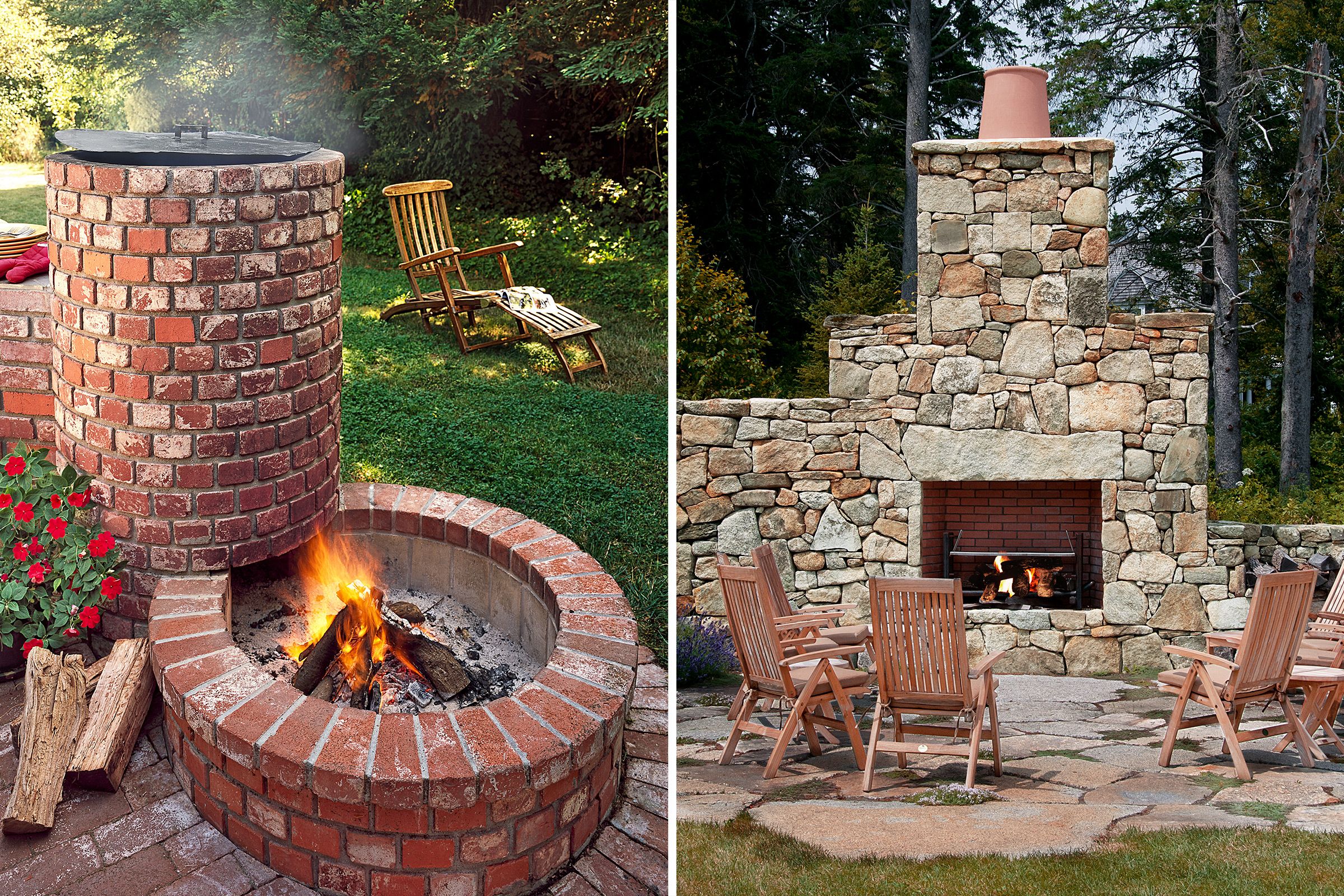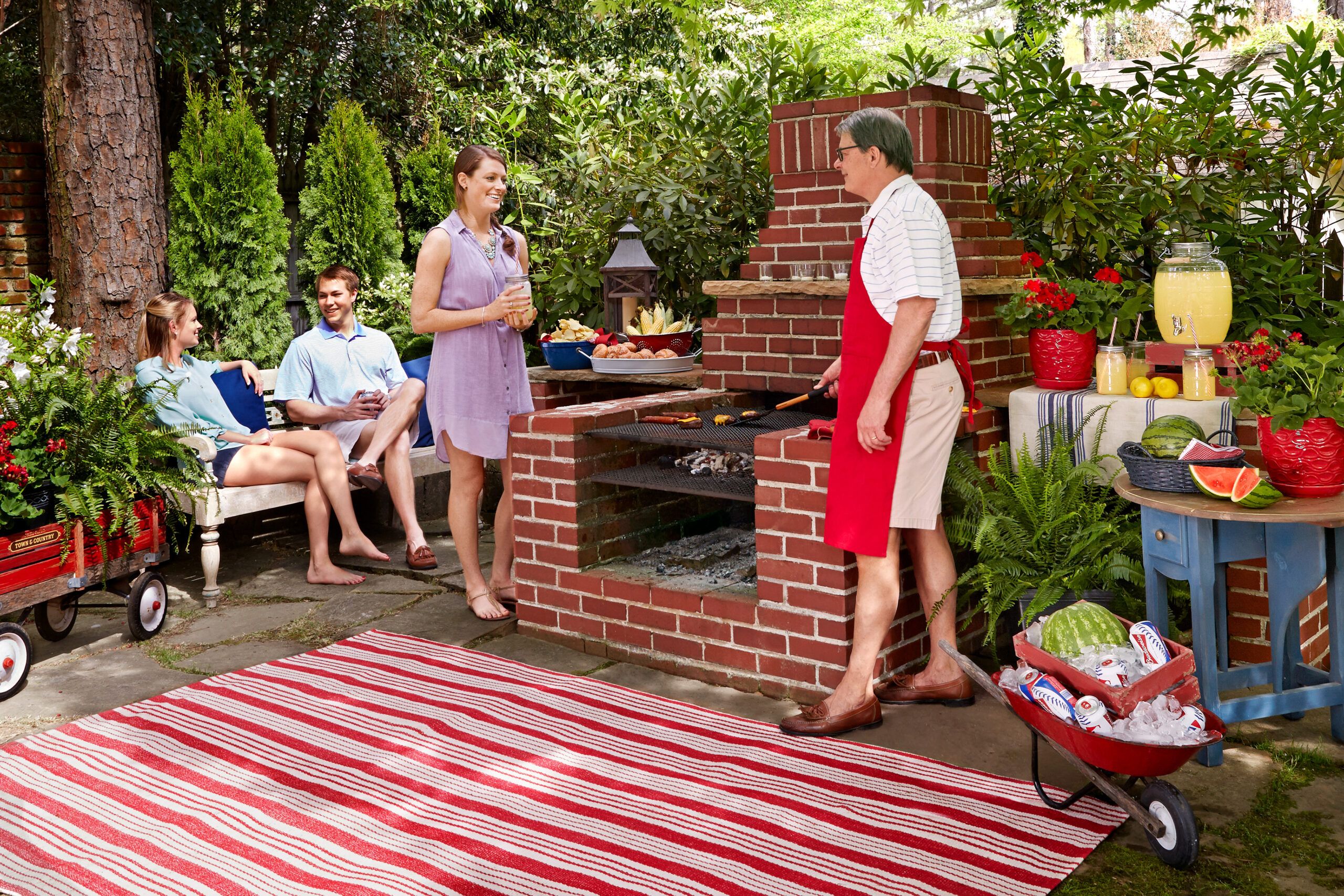Built-in barbecue pits give you an outdoor cooking space that doubles as a focal point for summer gatherings. Building a simple BBQ pit is a relatively easy job and likely to cost less than a fancy new gas grill.
With the right tools, materials, and a little skill, you can put together a basic brick barbecue in a weekend. In this guide, we will explore everything you need to know about built-in barbecue pits, from their benefits and types to how to install and maintain them.
Anatomy of a Simple Brick BBQ Pit

Built-in BBQs typically offer more grilling space than standard portable units, making it easier to cook for larger groups. The sturdy construction also provides better heat retention, leading to more consistent cooking temperatures and potentially better-tasting food. Here are their main components:
- Firebox: The inner wall of the barbecue may be lined with fire brick—called refractory brick and made of fire clay—for added heat retention.
- Grill grate: Choose rustproof, porcelain-coated cast iron or stainless steel. Can be supported by angle irons or brick ledges.
- Base: A 3- to 4-inch-thick pad of fiber-reinforced concrete over a 3- to 4-inch base of tamped crushed stone provides stability.
- Solid-brick walls: These are finished on top with header and stretcher borders.
- Charcoal/ash pan: A solid-metal sheet holds fuel and simplifies ash removal. Space it 7 to 15 inches below the cooking surface.
Adding a well-designed built-in barbecue pit can also boost your home’s value. Potential buyers often view outdoor cooking areas as desirable features that help your home stand out, making your property more attractive in the real estate market.
Planning Your Built-In BBQ Project
When planning a new built-in BBQ project for your yard, consider these key factors before breaking ground to ensure a smooth and well-executed installation.
Material Options
Choosing the right material for your barbecue pit is essential for durability, heat retention, and aesthetic appeal. Here are some popular options to consider, listed from cheapest to most expensive.
Concrete Block
Concrete block is the least expensive option and allows for a smaller footprint than other options. Concrete blocks are readily available and simple to work with, making them ideal for DIY projects. They’re also highly durable and can withstand high temperatures, making them suitable for fire pits. However, fire pits made of concrete are not always the prettiest.
Brick
Brick is a mid-range option due to its attractive appearance, excellent heat retention, and durability. As a fire-hardened material, brick withstands exposure to the elements well. Look for “facing bricks,” which serve as both structural and finish materials and have recesses to hold mortar. Achieving uniform courses may require above-average DIY skill.
Stone
Quarried stone is the most expensive option, but offers the most natural look and retains heat effectively. Expect to spend considerable time selecting, shaping, and fitting stones together. It’s advisable to have extra material on hand, depending on the type of stone used.
Fuel Options
Built-in BBQs can be designed to use various fuel types, including charcoal, wood, or gas. Each fuel option offers different flavors and cooking experiences. For traditional charcoal grilling, consider using natural briquettes or hardwood lump charcoal for a clean, hot burn. Hardwood logs can add a smoky flavor but require more time to burn down to cooking temperature. Gas options provide ease and precision, appealing to those who prefer quick and controlled cooking.
Grill Size and Cooking Surface
The size of your grill grates will determine how much food you can cook at once. Consider your typical cooking needs when choosing grate size. For materials, opt for rustproof options like porcelain-coated cast iron or stainless steel for durability and easy cleaning. The layout and design of your cooking surface can also facilitate different cooking techniques, such as indirect grilling or smoking.
Location
When determining the best spot for your built-in BBQ, consider factors like prevailing winds to ensure smoke doesn’t blow towards your dining area or into your home. Determine which way the prevailing winds blow, and site the barbecue so that the smoke will blow away from the cook and the dining area. Proximity to your indoor kitchen and the overall layout of your outdoor space are also important considerations.
Budget
Built-in BBQ costs can vary widely depending on materials, size, and additional features. A basic DIY brick BBQ might cost around $500 for materials, while more elaborate designs or professional installations can run much higher. Set a realistic budget that accounts for all aspects of the project, and include a contingency fund for unexpected costs or additions that may enhance the final result.
Permits
Before starting construction, check with your local building department about any required permits. Some areas have specific regulations regarding outdoor cooking structures, especially in regions prone to wildfires.
DIY vs. Professional BBQ Pit Installation
Deciding whether to build your BBQ pit yourself or hire a professional depends on your skills, time, and budget. Both options have their pros and cons.
DIY installation can save a substantial amount of money and provide a sense of self-achievement. If you have basic masonry skills and the right tools, building a simple brick BBQ is achievable. However, more complex designs or materials may require specialized skills. Projects like stone BBQs or those with integrated smoker components might be challenging for anyone besides the most experienced DIYers.
Consider hiring a professional for complicated masonry work, custom designs, or if you’re unsure about any aspect of the installation process. A professional can ensure proper construction, adherence to local codes, and may offer design insights you hadn’t considered.
Maintenance and Care for Your Built-In BBQ
Proper maintenance will extend the life of your built-in BBQ and ensure safe, enjoyable use for years to come. Here are some easy maintenance tips you should follow to keep your built-in BBQ in top condition.

Cleaning Tips
Regular cleaning is essential. Brush hot grill grates after each use to prevent food buildup. When cooled, spray grates with vegetable oil to prevent rusting. Dispose of cold ash after each use to prevent excess smoke and unpleasant flavors in future cooking sessions.
Winterizing Your BBQ Pit
In colder climates, take steps to protect your BBQ during winter months. Cover the pit to prevent water damage, and consider applying a sealant to brick or stone surfaces to prevent moisture absorption and cracking. Proper winterization can prevent weather-related damage and extend the life of your BBQ pit.
Addressing Common Issues
Watch for signs of wear or damage, such as cracked mortar or loose bricks. Address these issues promptly to prevent more significant problems. If you notice uneven heating or poor performance, check for blockages in air vents or damage to the firebox. Timely repairs can keep your BBQ pit functioning well and prevent more costly fixes later.
Safety Considerations for Built-In BBQs
Ensure your BBQ area has adequate ventilation to prevent smoke buildup and reduce fire risks. This is especially important if your pit is near covered areas or walls. Proper ventilation enhances safety and improves cooking conditions.
Follow local fire safety codes, which typically require BBQs to be at least 10 feet from buildings and combustible surfaces. Keep a fire extinguisher nearby, and never leave a lit grill unattended.
Practice proper food handling and cooking techniques to prevent foodborne illness. Use separate utensils for raw and cooked foods, and ensure meats reach safe internal temperatures before serving.
Comparing Built-In BBQs To Other Outdoor Cooking Options
Built-in BBQs offer unique advantages over other outdoor cooking setups, but it’s worth considering how they stack up against the best alternatives.
Built-In vs. Portable Grills
While portable grills offer flexibility, built-in BBQs provide stability, durability, and often more cooking space. They’re also a permanent feature that can enhance your outdoor living area’s aesthetics and functionality.
Built-In BBQs vs. Outdoor Kitchens
Built-in BBQs can be a stepping stone towards a full outdoor kitchen. They offer many of the cooking benefits at a lower cost and with less complexity than a complete outdoor kitchen setup. However, they may lack some amenities like sinks or refrigeration that full outdoor kitchens provide. Considering your cooking needs and budget can help you decide which option is best for you.
Barbecue Pit Additions
Once you have the main pit in place, you can add a variety of decorative or functional accessories. Here are a few of the most popular.
Adjustable grate
Argentine-style “gaucho grills” feature a recessed firebox with a heavy-duty grate that has a cranking mechanism to raise and lower it over hot coals, regulating the heat. These products can be pricey. Consider having one made by a metalworker, starting around $700.

Grill-smoker combo
This cylindrical smoker — made from a brick-clad concrete drainpipe — is fueled by a fire pit that becomes a campfire-style grill with the addition of a grate.

Fireplace grill
Want to build a “wow” outdoor feature? Start with a precast fireplace kit, line it with fire brick, and clad it with stone veneer. Then turn it into a cooking hearth by adding angle irons to hold a grill grate.
Tips for Grilling
Jamie Purviance, chef, and author of Weber’s Big Book of Burgers (2014), shares tips — and a great recipe — to turn you into a grilling guru.
- Get it got: Preheating the grill for at least 15 minutes keeps meat from sticking and brings on enviable grill marks.
- Create zones: Form two temperature zones by moving all the hot coals to one side. The direct-heat area sears burgers perfectly, while the cooler zone gives you a place to let them “rest.”
- Hands off: No pushing or prodding the meat once it’s on the grill; 5 to 6 minutes on each side is all you need for a caramelized crust.
- Add smoky flavor: Soak a few handfuls of hardwood chunks in water, then drain and toss onto hot coals to subtle smokiness to grilled meats.
- Take five: Let hot burgers rest for a few minutes before diving in, to retain juices.
- Stop guessing: The surest way to ensure perfect doneness is by using an instant-read meat thermometer
Our Conclusion
Built-in barbecue pits offer a blend of functionality and aesthetic appeal for outdoor entertaining. They provide a durable, weather-resistant cooking option that can significantly enhance your outdoor living space. Whether you choose a DIY approach or professional installation, a well-designed built-in BBQ can become the heart of your backyard gatherings for years to come.

